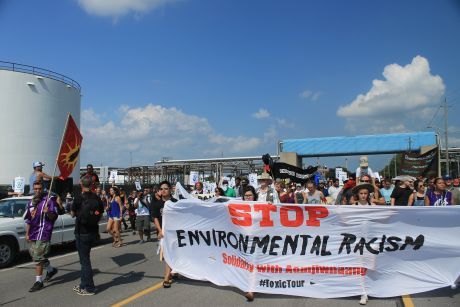Reports
You are here
Toxic Tour exposes environmental racism and builds resistance

September 9, 2015
On September 5 over 500 people joined the annual Toxic Tour of Canada’s Chemical Valley. Organized by Aamjiwnaang and Sarnia Against Pipelines (ASAP), the toxic tour exposes the companies driving the climate crisis, the environmental racism they impose on Indigenous communities, and the growing resistance.
Chemical colonialism
Chemical Valley, in southwestern Ontario, produces 40 per cent of Canada’s petro-chemicals, and includes more than 60 industrial facilities—which completely surround Aamjiwnaang First Nation. As the organizers explain, “In Aamjiwnaang everything is polluted air, soil, water, and people. Some of the land Industry has now made their empire on is stolen land or ongoing projects that have little to no consent.” While the settler village of Blue Water was relocated a generation ago, Chemical Valley continues to expand and poison Aamjiwnaang—unleashing daily doses of environmental racism.
As the Toxic Tour showed, massive refineries loom over the community baseball field and basketball court, and encase the community cemetery—continuing to poison those whose lives were cut short by toxins. Along the way, community members told their experiences of being poisoned by chemical releases and the local hospital having no idea what the cause or treatment was. None of these companies have taken any responsibility, so sisters Vanessa and Lindsay Gray have raised their own funds to test the water for chemicals.
The tour passed by multiple signs warning of hydrocarbons, and by factories bearing the names of the major polluters—including Dow chemical, Suncor and Imperial Oil. But despite the endless stretch of refineries there was not a worker in sight. While the NDP and Green parties oppose some of Harper’s pipelines, they support refineries supposedly because of jobs. But the petrochemical industry is the least efficient job creator, and it destroys the planet on which all our jobs and lives depend. As one community member reminder us on the tour, “the earth is the economy.”
Resistance
As well as exposing chemical colonialism, the Toxic Tour revealed the growing resistance. As ASAP explained, “Aamjiwnaang has fought back. Grassroots members have done speaking tours, petitions, lawsuits, rallies, blockades, scientific testing, and built networks of supporters to help share the story of what is happening to our lands, and our people.”
Vanessa, Lindsay and other local organizers have not only exposed Chemical Valley’s impacts on their own community, they have also helped build the climate justice movement across the region against Line 9 and tar sands. This growing climate justice network rallied the largest Toxic Tour to date—with buses from Montreal, Toronto, Hamilton, Kitchener Waterloo, Guelph and London. Anger against environmental racism was matched by climate justice inspiration. Along the tour, the lifeless factory sounds were broken by political hip hop and climate justice chants: “No more chemicals in the valley! Clean water, clean air, healthy families!”
For more information visit aamjiwnaangsolidarity.com
Section:










